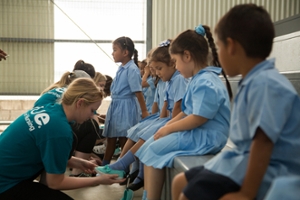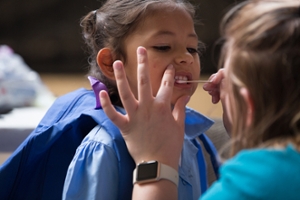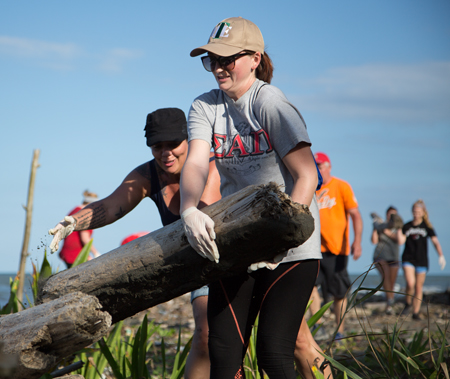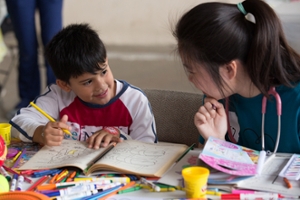 Southern Illinois University Edwardsville Chancellor Randy Pembrook, PhD, introduced Central American Mission Projects (CAMP) to SIUE during 2017 as an active element of his focus on community service and the University’s mission to shape a changing world. During Spring Break 2018, a group of more than 30 students, faculty and staff from SIUE’s Schools of Nursing, Pharmacy, and Education, Health and Human Behavior upheld the University’s mission, arriving in Costa Rica on Saturday, March 3 for a week of service and educational activities.
Southern Illinois University Edwardsville Chancellor Randy Pembrook, PhD, introduced Central American Mission Projects (CAMP) to SIUE during 2017 as an active element of his focus on community service and the University’s mission to shape a changing world. During Spring Break 2018, a group of more than 30 students, faculty and staff from SIUE’s Schools of Nursing, Pharmacy, and Education, Health and Human Behavior upheld the University’s mission, arriving in Costa Rica on Saturday, March 3 for a week of service and educational activities.
“These trips provide a special combination of opportunities for service to mankind through valuable hands-on experiences, all while experiencing growth in cultural awareness,” Pembrook said. “It’s always gratifying to see students enjoy activities beyond their professional aspects as they distributed shoes to children, painted an orphanage, saw the beauty of Costa Rica at a waterfall park and interacted with other students from different schools.”
 Pembrook is also thankful for the external support. “First, it is always a pleasure in working with our partner organization (CAMP),” he said. “Plus, it is impressive to see how many people support SIUE and CAMP’s outreach efforts. One individual donated 700 backpacks. People gave 2,500 pairs of shoes. The local Edwardsville Rotary gave $5,000 for dental equipment, and our Alumni Association donated toys, shoes and backpacks.”
Pembrook is also thankful for the external support. “First, it is always a pleasure in working with our partner organization (CAMP),” he said. “Plus, it is impressive to see how many people support SIUE and CAMP’s outreach efforts. One individual donated 700 backpacks. People gave 2,500 pairs of shoes. The local Edwardsville Rotary gave $5,000 for dental equipment, and our Alumni Association donated toys, shoes and backpacks.”
Highlights of the trip included:
Sunday, March 4 – Eleven School of Pharmacy (SOP) students headed into Carara National Park along the Tarcoles River to study medicinal plants. Within the SOP’s elective medicinal plants and tropical diseases course, students have a travel study portion to explore different regions of Costa Rica.
“The students in our program do not get enough exposure to medicinal plant use, nor do they have a solid enough base about tropical diseases that are spreading to the U.S.,” said Cathy Santanello, SOP associate professor of pharmaceutical sciences. “This group was particularly enthusiastic and curious. We went to places like Carara National Park and Manuel Antonio National Park where guides pointed out specific trees or plants that are used for medicinal purposes in Central America and what they are used for.
“We also saw amazing wildlife such as Capuchin and howler monkeys, scarlet macaws, crocodiles and anteaters in the wild. We met with SIUE nursing students and faculty, as well, to talk about our experiences and to exchange ideas.”
“The focus of the trip was to learn about medicinal plants and their use in Costa Rica, and also to learn from experts about tropical diseases,” said Marcelo Nieto, SOP associate professor of pharmaceutical sciences. “In the guided tour through Carara National Park, we heard about traditional medicine, native plants and the folk use of those medicinal plants. In another national park, students hiked and walked around to not only learn and find some known medicinal plants, but also to enjoy the wild life.”
Monday, March 5 – Thirteen School of Nursing (SON) students served approximately 80 patients in the Santo Tomas Clinic at Santo Domingo de Heredia and were prepared to serve even more throughout the week.
Valerie Griffin, DNP, assistant clinical professor and Family Nurse Practitioner Program coordinator, enjoyed seeing the students step out of their comfort zones not only as nursing students, but also as human beings. “They seemed surprised at what they were capable of accomplishing,” she said. “The experiences in Costa Rica will help to build their confidence as they become new nurses. The word ‘joy’ can be used to describe the interactions between the students and the children at the schools and organizations we served.”
On Tuesday and Wednesday, the SON students and faculty assisted local organizations with health assessments of more than 200 children from the community. They learned how to translate physical assessment findings into Spanish and then had time to share lunch and playtime with the children. Even through language barriers, you could see them sharing smiles and love for each another.
 Tuesday and Wednesday, March 6-7 – Six public health students from the School of Education, Health and Human Behavior (SEHHB) experienced life in the Village of Parismina on the Caribbean Coast. They took a boat to Tortuguero National Park, a protected wilderness area famous for its sea turtle nesting grounds. The students helped clear the beach in preparation for the turtle nesting season, and studied public and environmental health issues.
Tuesday and Wednesday, March 6-7 – Six public health students from the School of Education, Health and Human Behavior (SEHHB) experienced life in the Village of Parismina on the Caribbean Coast. They took a boat to Tortuguero National Park, a protected wilderness area famous for its sea turtle nesting grounds. The students helped clear the beach in preparation for the turtle nesting season, and studied public and environmental health issues.
“Being immersed in such a remote, small, tight knit community and being able to interact with community members in different capacities allowed students to appreciate how the community lives and works together to provide for each other,” said Michelle Cathorall, DrPH, assistant professor of public health in the SEHHB Department of Applied Health.
The public health students worked with the Association to Save the Turtles of Parismina (ASTOP), an organization founded by community members to help reduce turtle egg poaching. “All the people who took us on beach patrols were from the community,” Cathorall said. “One person gave us a lesson on turtles and the mating/nesting habits. That individual also runs a market in town where we shopped and is a local artisan that sold hand made crafts.
“We had similar interactions with multiple people in the community. It gave students an appreciation of many aspects of life that we take for granted, but also an appreciation for who the people are and how they live.”
Cathorall noted it wasn’t all work during the two days as students also snorkeled, rode horses on the beach and in the jungle, and ate seafood, all of which most of the students had never done and some were quite apprehensive about.
Thursday, March 8 – SOP students visited the Pharmacy at the University of Costa Rica in San Jose where they interacted with the Schools of Microbiology and Pharmacy faculty and students. The faculty gave presentations on medicinal plant use, tropical diseases (Zika, Ckikungunya and dengue disease) and water-borne pathogens.
“The lectures focused on medicinal plants and their use and also included a tour of their medical garden in which Dr. Weng (Professor of Pharmacognosy) showed us different medicinal plants and their use,” Nieto said. “One of the most rewarding aspects of the trip was to see how our students were so interested in learning, not only about the course topics but also the culture, trying new things every day, asking questions and even trying to speak the language.”
 Friday, March 9 – SON students visited an orphanage and delivered shoes and backpacks. Along with providing clinic assistance, they helped with home renovations. Among Griffin’s many goals in leading these trips is to encourage faculty and students to continue serving either locally or globally. All 13 students expressed a desire to continue this type of service.
Friday, March 9 – SON students visited an orphanage and delivered shoes and backpacks. Along with providing clinic assistance, they helped with home renovations. Among Griffin’s many goals in leading these trips is to encourage faculty and students to continue serving either locally or globally. All 13 students expressed a desire to continue this type of service.
Pembrook was impressed with the student nurses’ professionalism in patient health assessments and their personal touch in their outreach. “In short, the students were great!” he said “The nursing faculty were highly prepared, so the students had a great experience.”
“For many of the students, it showed them that they are capable of more than they might have thought possible,” Cathorall said. “This trip pushed them mentally, and especially physically, and they never gave up or said they couldn't do it.”
Another outcome from the trip was a signed memorandum of understanding (MOU) with the University of Costa Rica that will provide opportunities for future exchanges, involving students, faculty and research projects.
Photo: Upper Right-School of Nursing student Kristen Highfill helps distribute shoes and a child has her teeth checked.
Middle-Public health students help to clear a beach.
Lower Right-School of Nursing student Yu Cao colors with a young boy.